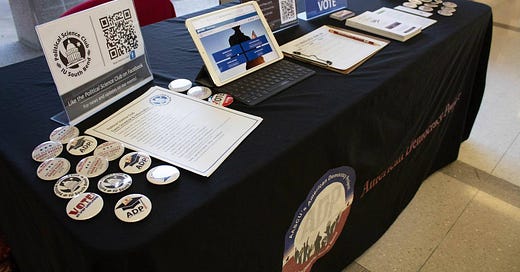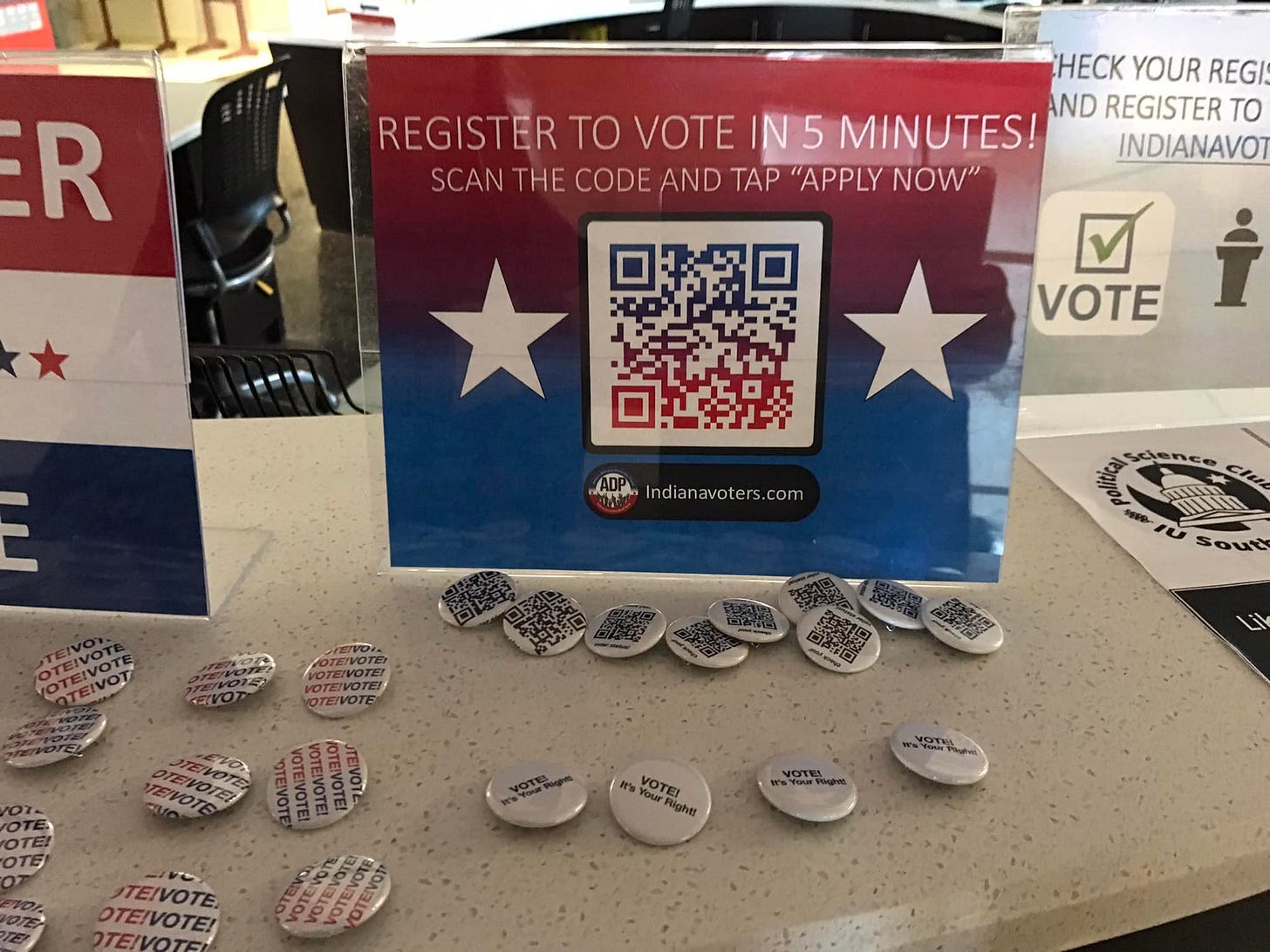Personalizing student voter engagement in an increasingly digital higher education experience
There's no silver bullet, but some strategies are more impactful than others.
One of the most important trends currently re-defining the higher education experience is the growing proportion of educational experiences taking place online. Online and hybrid education options are increasingly popular as older working adults and traditional-aged college students seek out such options. Between 2012 and 2016 the percent of online enrollment in universities increased 17.2 percent while overall enrollment decreased. This trend accelerated during the pandemic as even the most reluctant colleges and universities were pushed online, following a decade of growth in post-secondary alternatives including MOOCs, industry-driven certificate programs, and coding bootcamps. In the 2022-23 academic year, over half of U.S. students –53 percent—were enrolled in at least one online course. Given this change in the higher education landscape, engaging students where they are increasingly means reaching them online.
Where academic engagement goes, civic engagement must follow
More and more classes are following a remote or hybrid model, migrating the academic experience to the laptop. This in turn reduces the need for students to be physically on campus at all, cutting into the potential impact of on-campus, in-person mobilizations intended to help students register to vote or cast a ballot.
Increased digital outreach is an obvious response, but successful digital outreach strategies have proven tricky. A large-scale email outreach experiment proved ineffective at registering new voters, regardless of the message or sender, with registration rates in the treatment group actually declining by 0.3 percentage points (as students passed by more effective in-person options) and no effect on voter turnout. A follow-up experiment using email to connect students directly to online voter registration systems confirmed the null effect of linking students to PDF registration forms but found the registration rates for previously unregistered students were boosted by 1.6 percentage points and turnout was boosted by 0.5 percentage points, a small, but (statistically and substantively) significant difference.
These experiments demonstrate that there are more layers to successful outreach than “go digital.” A similar lack of impact found with large-scale impersonal social media advertising, such as banner ads and “I Voted” widgets, when contrasted with the small but significant effect of showing people that their friends voted, suggests a need for some level of personalization beyond simply publishing a message with important information on a platform where students might encounter it.
Promising approaches for digital outreach
The article Educating Students for Democracy (Bennion and Michelson 2023) explores several promising strategies for digital outreach, including friend-to-friend communication on social media and scheduled follow-up:
Targeted social media messaging from known sources shows promise: Students seem to draw an important distinction between “messaging” and “advertising.” While students seem to tune out most paid content, students who participated in a 2010 experiment were added as Facebook friends by a professor, Holly Teresi, who posted regular status updates about the upcoming midterm elections. Students exposed to the election content turned out for the election at an 8.22% higher rate than students in the study’s control group. Target messages from trusted senders (e.g. professors, peers, family and friends) appear to be more effective than generic messages from large businesses or organizations.
Campuses may also provide targeted messages, relying on their status as trusted messengers: New York’s Stony Brook University sends automatic reminders to students who registered to vote in the past if their voter status is inactive, their identification has not yet been verified, or the address where they are registered to vote does not match their current address. The reminders include specific information about how to update their information. Additional research, including randomized controlled experiments, are needed to evaluate whether these follow-up efforts affect voter participation.
The upshot: Personalized digital outreach is promising, but there are many questions still unanswered.
A review of the literature on successful GOTV techniques makes one thing clear: the most effective way to mobilize new voters is to catch their attention and to personalize the invitation to vote in ways that make them feel as if their vote is significant—as if they are more than a number and somebody cares if they, as individuals, go to the polls.
The biggest challenge to registering and mobilizing young voters is often capturing their attention. While a campus-wide mass email connecting students directly to an online voter registration system resulted in a statistically significant increase in student voter registration and turnout rates, the effect was small and it is easy for students to ignore email. Randomized controlled studies are needed to test the effectiveness of embedding registration and election reminders into course enrollment, parking pass purchases, matriculation surveys, and course management systems.
There is reason to believe that direct digital outreach to students on platforms that they are required to use will increase voter engagement. A Student Vote Research Network funded project by Elizabeth Bennion and Kyle Kenyon suggests that one way to move students to action is to use Canvas announcements posted by professors – an approach that capitalizes on the fact that students generally pay attention to platforms that deliver the curriculum and track their grades. (Look for future content in this Substack exploring this research).
The Ask Every Student approach to voter registration, education and mobilization is promising. It requires collaboration among campus officials, faculty, and staff across departments to integrate voter registration and education into existing systems and processes students regularly encounter, including in-person freshman seminars and required courses, new student orientation, bookstore and ID pickup, and move-in day.
To actually reach every student, this approach must also include digital platforms (e.g. class registration, fall check-in, emergency address updates, social media) and both online synchronous and asynchronous classes.
Each strategy operates at a different level of tension between personalization and broadened reach, and some institutions lack the budget, staff, or resources they need to fully execute their desired strategy. There is no one silver bullet to achieving full student voter registration and turnout, but understanding the need for personalization and reach, the capabilities necessary to achieve them, and the resource cost of each will help student vote leaders on campuses around the country optimize their time and resources to achieve the best possible outcomes. Future research can help them by answering the following questions:
How much and what type of digital follow-up has the greatest positive impact on student voter turnout?
Does embedding voter registration in Learning Management Systems and mandatory digital activities, such as contact information updates and class registration, increase student registration and turnout rates?
How can universities create the conditions for the organic creation of social networks and content that encourages political participation among students in a positive, inclusive manner?
Effective digital outreach requires balancing broad accessibility with the personal touch vital for motivating student voter participation. As higher education rapidly evolves, those working to engage students civically must similarly adapt outreach to students' increasingly digital experiences.







Amazing
Scholars seeking more information about the large-scale field experiments (or other studies) I referenced in this piece are welcome to contact me directly at my Indiana University iu.edu email address. I am pleased to know that several scholars are seeking to replicate and extend my past research findings. Let's keep building our knowledge together!